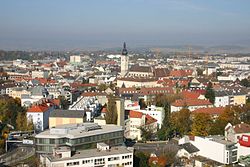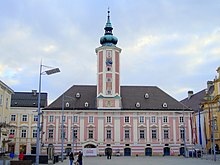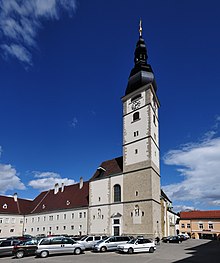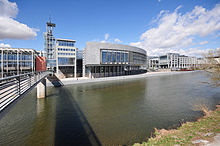Statutory city in Lower Austria, Austria
| Sankt Pölten Sant Pödn (Bavarian) | |
|---|---|
| Statutory city | |
     From top down, left to right: Rathausplatz with Franciscan Church and Monastery, Sankt Pölten Cathedral, view of the city, City Hall, Lower Austrian Government Quarter
From top down, left to right: Rathausplatz with Franciscan Church and Monastery, Sankt Pölten Cathedral, view of the city, City Hall, Lower Austrian Government Quarter | |
 Coat of arms Coat of arms | |
 Location of St. Pölten within Lower Austria Location of St. Pölten within Lower Austria | |
  | |
| Coordinates: 48°12′00″N 15°37′00″E / 48.20000°N 15.61667°E / 48.20000; 15.61667 | |
| Country | |
| State | |
| District | Statutory city |
| Government | |
| • Mayor | Matthias Stadler (SPÖ) |
| Area | |
| • Total | 108.44 km (41.87 sq mi) |
| Elevation | 267 m (876 ft) |
| Population | |
| • Total | 54,649 |
| • Density | 500/km (1,300/sq mi) |
| Time zone | UTC+1 (CET) |
| • Summer (DST) | UTC+2 (CEST) |
| Postal code | 3100, 3104, 3105, 3106, 3107, 3108, 3140, 3151, 3385 |
| Area code | 02742 |
| Vehicle registration | P |
| Website | www |
Sankt Pölten (German pronunciation: [zaŋkt ˈpœltn̩] ; Central Bavarian: St. Pödn), mostly abbreviated to the official name St. Pölten, is the capital and largest city of the State of Lower Austria in northeast Austria, with 55,538 inhabitants as of 1 January 2020. St. Pölten is a city with its own statute (or Statutarstadt) and therefore it is both a municipality and a district in the Mostviertel. Due to its cultural status, it has recently enjoyed an increase of visitors passing through Sankt Pölten on their way to Vienna.
Geography
The city lies on the Traisen river and is located north of the Alps and south of the Wachau. It is part of the Mostviertel, the southwest region of Lower Austria.
Subdistricts
St Pölten is divided into the following subdistricts: Altmannsdorf, Dörfl at Ochsenburg, Eggendorf, Ganzendorf, Hafing, Harland, Hart, Kreisberg, Matzersdorf, Mühlgang, Nadelbach, Oberradlberg, Oberwagram, Oberzwischenbrunn, Ochsenburg, Pengersdorf, Pottenbrunn, Pummersdorf, Ragelsdorf, Ratzersdorf at the Traisen, Reitzersdorf, Schwadorf, Spratzern, St Georgen on the Steinfelde, St Pölten, Stattersdorf, Steinfeld, Teufelhof, Unterradlberg, Unterwagram, Unterzwischenbrunn, Viehofen, Völtendorf, Waitzendorf, Wasserburg, Weitern, Wetzersdorf, Windpassing, Witzendorf, Wolfenberg, Wörth and Zwerndorf.
Transport
The city's main railway station, St. Pölten Hauptbahnhof, is located directly on the West railway of the ÖBB and is also the terminus of the Leobersdorfer Railway, the Mariazellerbahn, the regional railway to Tulln and the regional railway to Krems. It is at the intersection of the Western Motorway A1 and the Kremser Speedway S33, and is traversed by the Vienna Road B1. St Pölten is a junction of the Wieselbus bus lines, which provides radial connections between the capital and the different regions of Lower Austria.
In the city
Between 1911 and 1976, a tramline operated in St Pölten. Today, a network of eleven bus lines operates at regular intervals within the city. Every summer, a free tourist train in the city centre connects the ancient parts of the city with the government district.
Climate
| Climate data for Sankt Pölten (1991–2020) | |||||||||||||
|---|---|---|---|---|---|---|---|---|---|---|---|---|---|
| Month | Jan | Feb | Mar | Apr | May | Jun | Jul | Aug | Sep | Oct | Nov | Dec | Year |
| Record high °C (°F) | 17.9 (64.2) |
19.2 (66.6) |
24.3 (75.7) |
30.9 (87.6) |
32.2 (90.0) |
37.7 (99.9) |
37.6 (99.7) |
38.2 (100.8) |
34.2 (93.6) |
28.0 (82.4) |
23.6 (74.5) |
16.4 (61.5) |
37.7 (99.9) |
| Mean daily maximum °C (°F) | 2.5 (36.5) |
5.3 (41.5) |
10.0 (50.0) |
16.5 (61.7) |
20.1 (68.2) |
24.5 (76.1) |
25.7 (78.3) |
25.4 (77.7) |
20.5 (68.9) |
13.8 (56.8) |
7.9 (46.2) |
3.2 (37.8) |
14.6 (58.3) |
| Daily mean °C (°F) | 0.2 (32.4) |
1.7 (35.1) |
6.0 (42.8) |
11.0 (51.8) |
15.4 (59.7) |
19.0 (66.2) |
20.9 (69.6) |
20.6 (69.1) |
15.8 (60.4) |
10.5 (50.9) |
5.3 (41.5) |
1.0 (33.8) |
10.6 (51.1) |
| Mean daily minimum °C (°F) | −2.2 (28.0) |
−1.6 (29.1) |
1.6 (34.9) |
5.6 (42.1) |
9.6 (49.3) |
13.6 (56.5) |
14.7 (58.5) |
14.5 (58.1) |
11.0 (51.8) |
6.4 (43.5) |
2.6 (36.7) |
−1.2 (29.8) |
6.2 (43.2) |
| Record low °C (°F) | −22.1 (−7.8) |
−20.7 (−5.3) |
−23.1 (−9.6) |
−4.3 (24.3) |
0.6 (33.1) |
2.9 (37.2) |
6.8 (44.2) |
7.0 (44.6) |
1.1 (34.0) |
−6.9 (19.6) |
−13.4 (7.9) |
−20.0 (−4.0) |
−23.1 (−9.6) |
| Average precipitation mm (inches) | 31.8 (1.25) |
25.9 (1.02) |
45.5 (1.79) |
45.4 (1.79) |
93.7 (3.69) |
105.7 (4.16) |
102.8 (4.05) |
101.4 (3.99) |
74.5 (2.93) |
50.9 (2.00) |
41.1 (1.62) |
33.7 (1.33) |
752.4 (29.62) |
| Average snowfall cm (inches) | 16 (6.3) |
17 (6.7) |
8 (3.1) |
2 (0.8) |
0 (0) |
0 (0) |
0 (0) |
0 (0) |
0 (0) |
0 (0) |
6 (2.4) |
14 (5.5) |
64 (25) |
| Average relative humidity (%) (at 14:00) | 78.3 | 69.4 | 60.0 | 52.2 | 55.2 | 55.2 | 54.3 | 54.2 | 60.0 | 68.4 | 77.6 | 80.6 | 63.8 |
| Mean monthly sunshine hours | 60.0 | 92.0 | 146.3 | 203.0 | 230.9 | 243.7 | 253.3 | 251.7 | 179.6 | 123.8 | 62.6 | 50.3 | 1,897.2 |
| Percent possible sunshine | 23.2 | 33.1 | 40.4 | 50.3 | 50.1 | 52.0 | 53.7 | 58.1 | 48.7 | 38.0 | 23.9 | 20.6 | 41.0 |
| Source: Central Institute for Meteorology and Geodynamics (snowfall 1981-2010) | |||||||||||||
| Climate data for Sankt Pölten (1971–2000) | |||||||||||||
|---|---|---|---|---|---|---|---|---|---|---|---|---|---|
| Month | Jan | Feb | Mar | Apr | May | Jun | Jul | Aug | Sep | Oct | Nov | Dec | Year |
| Record high °C (°F) | 16.2 (61.2) |
19.2 (66.6) |
25.6 (78.1) |
27.3 (81.1) |
30.8 (87.4) |
34.9 (94.8) |
37.0 (98.6) |
38.2 (100.8) |
33.8 (92.8) |
26.9 (80.4) |
23.4 (74.1) |
14.6 (58.3) |
38.2 (100.8) |
| Mean daily maximum °C (°F) | 1.8 (35.2) |
4.0 (39.2) |
9.7 (49.5) |
14.5 (58.1) |
20.3 (68.5) |
22.8 (73.0) |
25.0 (77.0) |
25.1 (77.2) |
20.1 (68.2) |
14.0 (57.2) |
6.5 (43.7) |
3.0 (37.4) |
13.9 (57.0) |
| Daily mean °C (°F) | −1 (30) |
0.4 (32.7) |
4.7 (40.5) |
8.9 (48.0) |
14.3 (57.7) |
17.2 (63.0) |
19.1 (66.4) |
18.9 (66.0) |
14.5 (58.1) |
9.1 (48.4) |
3.5 (38.3) |
0.4 (32.7) |
9.2 (48.6) |
| Mean daily minimum °C (°F) | −3.3 (26.1) |
−2.3 (27.9) |
1.1 (34.0) |
4.4 (39.9) |
9.2 (48.6) |
12.3 (54.1) |
14.1 (57.4) |
14.0 (57.2) |
10.6 (51.1) |
5.9 (42.6) |
1.3 (34.3) |
−1.7 (28.9) |
5.5 (41.9) |
| Record low °C (°F) | −22.1 (−7.8) |
−20.7 (−5.3) |
−23.1 (−9.6) |
−4.8 (23.4) |
−0.9 (30.4) |
2.4 (36.3) |
6.8 (44.2) |
5.6 (42.1) |
1.3 (34.3) |
−6.9 (19.6) |
−13.4 (7.9) |
−20 (−4) |
−23.1 (−9.6) |
| Average precipitation mm (inches) | 29.5 (1.16) |
31.9 (1.26) |
42.1 (1.66) |
53.4 (2.10) |
73.5 (2.89) |
82.9 (3.26) |
88.1 (3.47) |
75.7 (2.98) |
56.3 (2.22) |
38.1 (1.50) |
48.9 (1.93) |
38.6 (1.52) |
659.0 (25.94) |
| Average snowfall cm (inches) | 18.1 (7.1) |
16.5 (6.5) |
10.1 (4.0) |
4.0 (1.6) |
0.0 (0.0) |
0.0 (0.0) |
0.0 (0.0) |
0.0 (0.0) |
0.0 (0.0) |
0.1 (0.0) |
7.4 (2.9) |
17.1 (6.7) |
73.3 (28.9) |
| Average precipitation days (≥ 1.0 mm) | 7.2 | 7.2 | 7.9 | 8.5 | 9.2 | 10.5 | 10.7 | 9.0 | 7.6 | 6.5 | 9.0 | 8.1 | 101.4 |
| Average relative humidity (%) (at 14:00) | 76.7 | 69.1 | 58.0 | 52.5 | 50.7 | 53.8 | 52.7 | 51.1 | 57.4 | 63.8 | 75.7 | 79.2 | 61.7 |
| Mean monthly sunshine hours | 55.2 | 87.4 | 129.7 | 168.8 | 224.6 | 221.9 | 234.9 | 232.5 | 165.8 | 118.3 | 58.8 | 45.4 | 1,743.3 |
| Percent possible sunshine | 22.3 | 33.6 | 38.7 | 44.4 | 50.7 | 49.3 | 51.4 | 55.5 | 47.6 | 38.6 | 23.2 | 19.3 | 39.6 |
| Source: Central Institute for Meteorology and Geodynamics | |||||||||||||
History
The oldest part of the city is built on the site of the ancient Roman city of Aelium Cetium that existed between the 2nd and the 4th century AD. A Benedictine monastery was founded in 791; in the year 799, it was called Treisma. St Pölten did not become a town until 1050, and officially became a city in 1169. Until 1494, St Pölten was part of the diocese of Passau, and then became the property of the state. In 1081 it hosted the Augustinian Chorherren, and in 1784 their Kollegiatsstift closed. Since 1785, this building has hosted the cathedral of St Pölten. The city replaced Vienna as the capital of Lower Austria with a resolution by the Lower Austrian parliament on 10 July 1986. The Lower Austrian government has been hosted in St Pölten since 1997.
The name Sankt Pölten is derived from St. Hippolytus of Rome (a martyred early Church Father). The city was renamed to Sankt Hippolyt, then clipped to St Polyt, and finally St Pölten.
Politics

Municipal council
The municipal council consists of 42 members and since the municipal elections in 2016 it consists of the following parties:
- 26 Social Democratic Party of Austria (SPÖ) – the mayor and the first vice mayor
- 9 Austrian People's Party (ÖVP) – the second vice mayor
- 6 FPÖ
- 1 The Greens – The Green Alternative
City's senate

The city's senate consists of 11 members:
- SPÖ: Martin Fuhs, Mag. Renate Gamsjäger, Engineer Franz Gunacker, Robert Laimer, Wolfgang Nowak, Mag. Johann Rankl, Mag. Ingrid Heihs
- ÖVP: Alfred Neuhauser, Josef Fraberger
- FPÖ
- Greens: Silvia Buschenreiter
Mayor
On 9 July 2004 the municipal council elected the former senator for culture Mag. Matthias Stadler (SPÖ) as the new mayor of St Pölten. The first vice mayor is Susanne Kysela (SPÖ); the second vice mayor is Johannes Sassmann (ÖVP).

Coat of arms, colours and seals
The arms' blazon is silver and azure; on the right a fess gules, on the left a wolf rampant silver langued gules and armed Or.
The colours of the city are red and yellow. The seal of the city contains its coat of arms surrounded by the text Landeshauptstadt St. Pölten. The administration's seal of the magistrate also contains the city's coat of arms with the text Magistrat der Stadt St. Pölten.
Economy
As of 15 May 2001, 40,041 people worked in 2,711 companies in the city. 23 of those companies are large-scale enterprises with more than 200 employees each.
Media
Several media companies are based in St Pölten. These are "@cetera", a literary-cultural magazine; "City-Flyer", an online magazine describing the cultural offerings of the city, which is published on paper monthly; "Campus Radio", a radio station from the University of Applied Sciences; "HiT FM", a radio station broadcasting in Lower Austria; "LetHereBeRock", an online youth magazine about the alternative rock scene; NÖN, a Lower Austrian newspaper; the Austrian Broadcasting Corporation for Lower Austria; and the local television channel "P3tv".
Large-scale enterprises
The largest companies based in St Pölten are the furniture producer Leiner, the paper manufacturer Salzer, and the family owned engineering conglomerate Voith.
Public facilities
Educational facilities
- Bundesgymnasium and Bundesrealgymnasium St. Pölten (public gymnasium)
- Public educational facility for kindergarten pedagogy and social pedagogy
- Public economics school and economics academy
- Bundesreal- and Bundesoberstufenrealgymnasium (BORG) Schulring (public high-level gymnasium)
- St. Pölten University of Applied Sciences (fields: computer simulation, media management, social work, telecommunication and media)
- Public higher educational facility for professions in economics and school for social professions
- Public higher technical educational facility and laboratory (fields: EDP and organisation, electronics, electrical engineering, machine engineering, economic engineering) with university of applied sciences for machine construction
- New Design University (interior architecture and graphics design)
- Lower Austrian state academy
- Philosophical-theological university
- Folk high school
- Lower Austrian institute for promotion of economy development (WIFI)
Leisure and sports sites


Swimming is available at Aquacity (indoor swimming pool), the St. Pölten outdoor swimming pool and Ratzersdorf Lake (a bathing pond where a nudist beach, beach volleyball, and miniature golf are available). For fitness training there is the City-Treff - Pueblo, the Lifeline, the Reebok and the Seepark. In addition, the city has:
- American Football Club - St. Pölten Invaders
- Badminton Club
- Golf club St. Pölten
- Skittles at the leisure park Megafun
- Miniature golf at the Tennis-Allround Center
- Model aircraft airport of the BSV VOITH
- Riding club St. Pölten-Wagram
- Shooting range of the private Schützenkompagnie
- Skatepark
- Gliding club St. Pölten
St Pölten hosts a primary base of the Lower Austrian state sports school.
Tennis
Every year in the third week of May the ATP tournament takes place in St Pölten. There are multiple local tennis stadiums, including the Arena im Aufeld, the tennis centre Allround, the tennis courts by the local ice sport association 1872, the courts in St. Georgen, the courts at the Ratzersdorfer Pond, the courts in the Lower Austrian state sports school and the courts of the leisure park Megafun.
International relations
See also: List of twin towns and sister cities in AustriaTwin towns – Sister cities
St Pölten is twinned with the following cities:
 Altoona, Pennsylvania, USA
Altoona, Pennsylvania, USA Brno, Czech Republic
Brno, Czech Republic  Clichy, Hauts-de-Seine, Île-de-France, France
Clichy, Hauts-de-Seine, Île-de-France, France Heidenheim, Baden-Württemberg, Germany
Heidenheim, Baden-Württemberg, Germany Kurashiki, Japan
Kurashiki, Japan Nyíregyháza, Hungary
Nyíregyháza, Hungary Wuhan, China
Wuhan, China
Culture and objects of interest






Theatres
- Lower Austrian state theatre
- Bühne im Hof
- Festspielhaus St. Pölten
Museums
- Diocese museum St. Pölten
- Museum im Hof
- Lower Austrian state museum
- Lower Austrian documentation institute for modern art
- Private museum "Wilhelmsburger ornament and utensil dishes"
- City museum St. Pölten
Others
- Repertory theatre Cinema Paradiso
- Former synagogue
- Klangturm (tower), the city's landmark
- Stadtsäle (public event hall)
- Youth culture hall frei.raum
- VAZ (Veranstaltungszentrum, event-centre)
- Drunter & Drüber (≈"haywire"; "higgledy-piggledy"; "topsy-turvy"), a pub in the inner city
- Tonkünstler Orchestra
- Business Center Niederösterreich
- Apotheke zum goldenen Löwen (pharmacy since 1545), oldest shop in town, famous baroque facing
Regular events
- ATP tennis tournament
- Cinema at the cathedral (Film am Dom)
- Capital city festival
- International culture and film festival
- Parliament festival
- St Pölten festival weeks "Klangweile"
- St Pölten Höfefest
- FM4 Frequency Festival
- Pro Golf Tour tournament
Notable people
See also: Category:People from Sankt Pölten
- Jakob Prandtauer (1660-1726), an Austrian Baroque architect, died locally.
- Ernst Stöhr (1860–1917), painter, graphic artist, writer and founding member of the Vienna Secession.
- Julius Raab, (1891–1964), conservative politician, Chancellor of Austria, 1953–1961
- Walter Fischer (1901–1978), medical doctor, journalist, radio broadcaster, poet and resistance fighter
- Maria Emhart (1901-1981), resistance activist, survived the Hitler years and became a national politician (SPÖ)
- Otto Demus (1902-1990), art historian and Byzantinist; member of the Vienna School of Art History
- Walter Graf (1903–1982), musicologist
- Heinrich Maier (1908–1945), priest and resistance fighter against Nazi Germany, attended local gymnasium
- Bernhard Wicki (1919–2000), Austrian-Swiss actor, film director and screenwriter
- Karl Österreicher (1923–1995), conductor, music educator, died locally
- Peter Minich (1927–2013), stage actor who became a tenor performing in operas, operettas and musical films
- Jörg Demus, (1928–2019), Austrian classical pianist
- Lolita (1931–2010), singer and actress
- Erwin Leder, (born 1951), actor e.g. Das Boot & Underworld
- Alfred Gusenbauer, (born 1960), politician (SPÖ) and former Chancellor of Austria, 2007/2008
- Martin Fiala, (DE Wiki) ((born 1961) Austrian composer.
- Oliver Stummvoll (born 1995), model
- The Clairvoyants (founded 2011), (Thommy Ten and Amélie van Tass) magician and mentalist duo.
Sport
- Franz Binder (1911–1989), a footballer and coach; played 242 games and 28 for Austria & Germany
- Karl Daxbacher (born 1953), football manager and player; played 393 games for FK Austria Wien & 6 for Austria
- Jochen Fallmann (born 1979), a football coach and a former player who played over 450 games.
- Markus Wagesreiter (born 1982), an handball player who has played 134 games for Austria
- Lukas Mössner (born 1984), a footballer who played over 370 games
- Maria Gstöttner (born 1984), football striker, played 467 games for SV Neulengbach and also for Austria women
- Benjamin Karl (born 1985), a snowboarder with medals from three Winter Olympics
Literature
- Klaus Nüchtern: Kleines Gulasch in St. Pölten (German): ISBN 3-85439-306-7
- Thomas Karl: St. Pölten – Ein Wandel durch die Zeit (German): ISBN 3-89702-641-4
- Otto Kapfinger, Michaela Steiner: St. Pölten neu (German): ISBN 3-211-82954-7
References
- "Dauersiedlungsraum der Gemeinden Politischen Bezirke und Bundesländer - Gebietsstand 1.1.2018". Statistics Austria. Retrieved 10 March 2019.
- "Einwohnerzahl 1.1.2018 nach Gemeinden mit Status, Gebietsstand 1.1.2018". Statistics Austria. Retrieved 9 March 2019.
- "St. Pöltner Stadtrecht 1977". Retrieved 28 February 2015.
- "Klimamittelwerte 1991–2020" (in German). Central Institute for Meteorology and Geodynamics. Archived from the original on 5 June 2023. Retrieved 11 April 2023.
- "Klimamittel 1981–2010: Schnee" (in German). Central Institute for Meteorology and Geodynamics. Archived from the original on 29 December 2014. Retrieved 24 November 2019.
- "Klimadaten von Österreich 1971–2000 – Niederösterreich-St. Pölten" (in German). Central Institute for Meteorology and Geodynamics. Archived from the original on 12 October 2019. Retrieved 24 November 2019.
- Fasching, Heinrich (1985). Dom und Stift St. Pölten und ihre Kunstschätze. Leinen: Verlag Niederösterr. Pressehaus. p. 19. ISBN 3853267270.
- "Home". bgstpoelten.ac.at.
- "Sister City program still alive | News, Sports, Jobs - Altoona Mirror". Retrieved 11 June 2020.
- "City of Brno Foreign Relations - Statutory city of Brno" (in Czech). City of Brno. 2003. Archived from the original on 15 January 2016. Retrieved 6 September 2011.
- "Brno - Partnerská města" (in Czech). City of Brno. 2006–2009. Retrieved 17 July 2009.
External links
- Official website (in English)
- Official website of BG/BRG St.Pölten
| Principal cities of Austria | |
|---|---|
| Administrative seats of Austrian provinces | |||
|---|---|---|---|
| Capitals of European states and territories | |||||||||||||||||||||||||||
|---|---|---|---|---|---|---|---|---|---|---|---|---|---|---|---|---|---|---|---|---|---|---|---|---|---|---|---|
| Capitals of dependent territories and states whose sovereignty is disputed shown in italics. | |||||||||||||||||||||||||||
| Sovereign states |
| ||||||||||||||||||||||||||
| States with limited recognition |
| ||||||||||||||||||||||||||
| Dependencies |
| ||||||||||||||||||||||||||
| Federal states |
| ||||||||||||||||||||||||||
| Autonomous entities |
| ||||||||||||||||||||||||||
| |||||||||||||||||||||||||||
